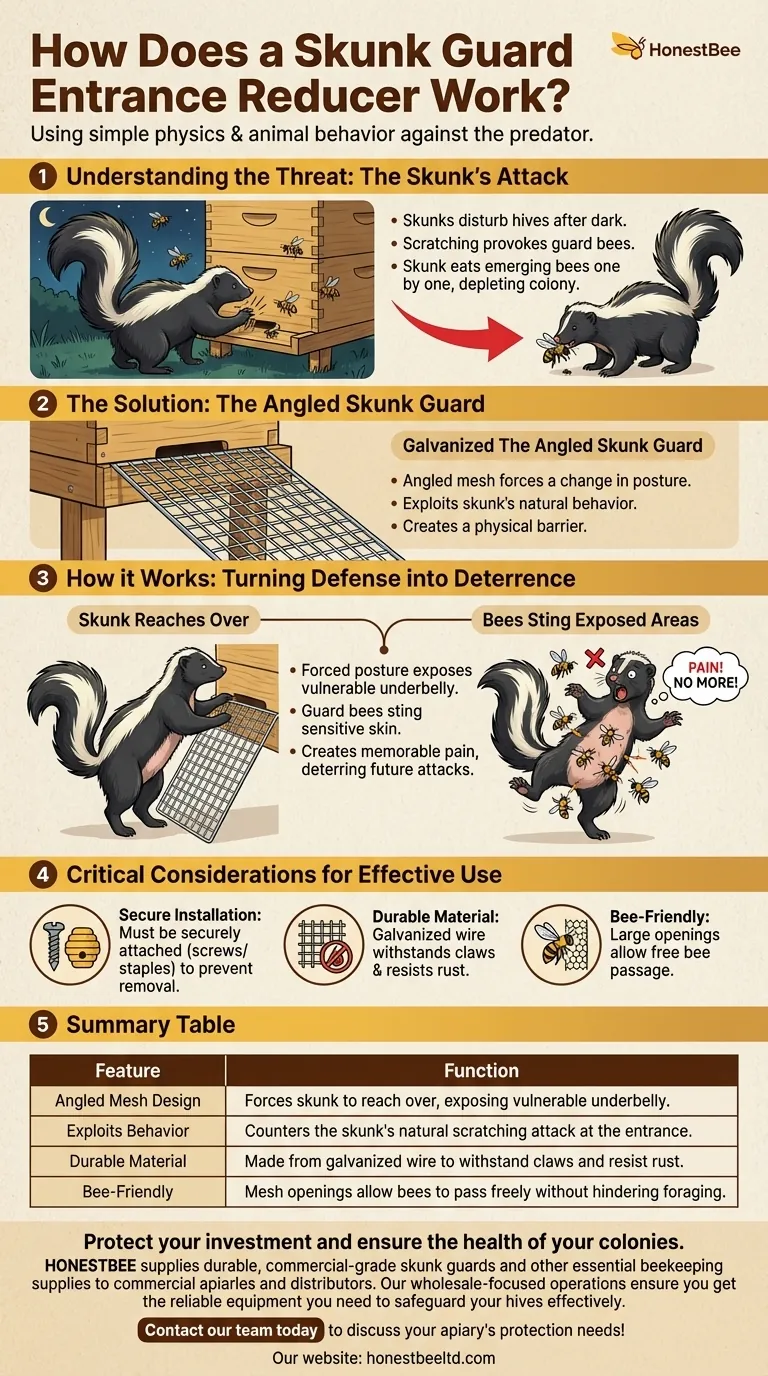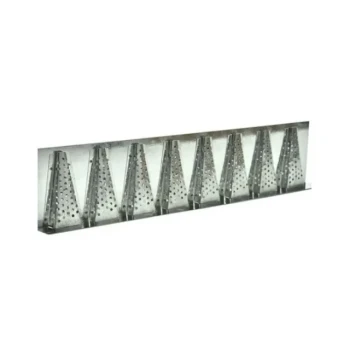At its core, a skunk guard entrance reducer works by using simple physics and animal behavior against the predator. It is a specifically angled piece of wire mesh that attaches to the front of a beehive, forcing a skunk to change its posture to access the entrance, which in turn exposes its vulnerable, sparsely-furred underbelly to the guard bees' stingers.
The skunk guard doesn't block the skunk; it changes the rules of engagement. By forcing the skunk to reach over the mesh, it turns the bees' natural defensive stings into a powerful and memorable deterrent that teaches the predator to leave the hive alone.

Understanding the Skunk's Threat to a Beehive
To appreciate how the guard works, you must first understand how a skunk attacks a colony.
The Skunk's Method of Attack
Skunks are nocturnal predators that disturb hives after dark. They approach the entrance and scratch at the landing board.
This disturbance provokes the colony's guard bees, which fly out to investigate and defend the hive.
As the bees emerge, the skunk catches and eats them one by one. Over time, this consistent predation can severely deplete a colony's population, weakening it significantly.
The Mechanics of the Skunk Guard
The skunk guard is a simple but brilliant device designed to counter this specific attack method. Its effectiveness comes from its shape and material.
The Angled Mesh Design
The guard is typically constructed from sturdy, galvanized wire mesh. It's shaped into a downward-sloping ramp or tunnel that extends out from the hive's bottom entrance.
The mesh is large enough for bees to pass through without any issue but creates a physical barrier that cannot be easily bypassed by a larger animal.
Exploiting the Skunk's Anatomy
A skunk's natural attack posture involves standing on the ground and scratching directly at the entrance. The angled guard makes this impossible.
To get its paws to the entrance, the skunk is now forced to climb or reach over the top of the wire mesh ramp.
Exposing the Vulnerable Underbelly
This change in posture is the critical feature. As the skunk places its front paws on the mesh and reaches toward the entrance, it exposes its soft, sensitive belly and feet.
Unlike its thick, protective back fur, a skunk's underside has very little hair, leaving its skin vulnerable.
Turning Defense into a Lasting Deterrent
When the guard bees emerge to defend against the scratching, they now have a perfect target. They sting the skunk's exposed belly and feet repeatedly.
This experience is intensely painful and memorable for the skunk. It quickly learns to associate your hive with pain and will typically cease its attacks, moving on to find an easier meal.
Critical Considerations for Effective Use
A skunk guard is only effective if installed and used correctly. Missteps can render it useless.
Secure Installation is Non-Negotiable
The guard must be securely attached to the hive body, typically with screws or heavy-duty staples.
A determined skunk is a strong animal. If the guard is merely placed in front of the entrance, the skunk will simply pull it away and continue its attack.
Material Choice Matters
The use of galvanized wire is intentional. It is durable enough to withstand a skunk's claws and resists rust, ensuring it will last for many seasons out in the elements.
It Doesn't Hinder the Bees
A common concern is whether the guard impacts bee traffic. The openings in the mesh are designed to be large enough for bees to fly through freely, so it does not interfere with normal foraging operations.
Making the Right Choice for Your Goal
Applying this tool is straightforward once you understand the principle.
- If your primary focus is reacting to an existing threat: Install a securely fastened skunk guard immediately on any hive showing signs of skunk predation (disturbed ground, chewed bees) to stop the population loss.
- If your primary focus is proactive prevention: Consider installing skunk guards as a standard part of your apiary setup, especially in areas with known skunk populations, to prevent the habit from ever forming.
- If your primary focus is building your own equipment: Ensure the angle of your DIY guard is steep enough and the length is sufficient to absolutely force the skunk to expose its belly, as a shallow angle may not be an effective deterrent.
By understanding the predator's behavior, this simple device empowers you to protect your colony effectively.
Summary Table:
| Feature | Function |
|---|---|
| Angled Mesh Design | Forces skunk to reach over, exposing its vulnerable underbelly. |
| Exploits Behavior | Counters the skunk's natural scratching attack at the entrance. |
| Durable Material | Made from galvanized wire to withstand claws and resist rust. |
| Bee-Friendly | Mesh openings allow bees to pass freely without hindering foraging. |
Protect your investment and ensure the health of your colonies. HONESTBEE supplies durable, commercial-grade skunk guards and other essential beekeeping supplies to commercial apiaries and distributors. Our wholesale-focused operations ensure you get the reliable equipment you need to safeguard your hives effectively. Contact our team today to discuss your apiary's protection needs!
Visual Guide

Related Products
- Beehive Entrance Reducer Guardian Metal Hive Entrance for Bees
- Multi-Functional Sliding Hive Entrance for Beekeeping
- Steel Round Disc Entrance Reducer for Flexzion Bee Hive Nuc Box Gate
- Multi-Functional Rotary Hive Entrance Disc for Beekeeping
- High Security Emlock Strap System
People Also Ask
- How can a Langstroth hive entrance be adjusted? Mimic Natural Bee Preferences for a Healthier Hive
- How big should a beehive entrance be? Optimize for Colony Health & Honey Production
- What are the different types of entrance reducers available? A Guide to Protecting Your Hive
- What are the features of the side with oblong holes in the entrance reducer? A Guide to Hive Defense & Health
- What are the two functions of the Entrance Reducer? Master Hive Defense and Safe Transport



















